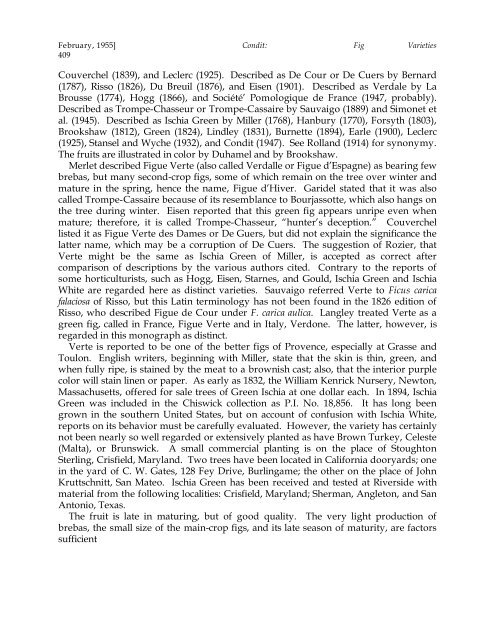Fig Varieties: A Monograph - uri=ucce.ucdavis
Fig Varieties: A Monograph - uri=ucce.ucdavis
Fig Varieties: A Monograph - uri=ucce.ucdavis
You also want an ePaper? Increase the reach of your titles
YUMPU automatically turns print PDFs into web optimized ePapers that Google loves.
February, 1955] Condit: <strong>Fig</strong> <strong>Varieties</strong><br />
409<br />
Couverchel (1839), and Leclerc (1925). Described as De Cour or De Cuers by Bernard<br />
(1787), Risso (1826), Du Breuil (1876), and Eisen (1901). Described as Verdale by La<br />
Brousse (1774), Hogg (1866), and Société’ Pomologique de France (1947, probably).<br />
Described as Trompe-Chasseur or Trompe-Cassaire by Sauvaigo (1889) and Simonet et<br />
al. (1945). Described as Ischia Green by Miller (1768), Hanbury (1770), Forsyth (1803),<br />
Brookshaw (1812), Green (1824), Lindley (1831), Burnette (1894), Earle (1900), Leclerc<br />
(1925), Stansel and Wyche (1932), and Condit (1947). See Rolland (1914) for synonymy.<br />
The fruits are illustrated in color by Duhamel and by Brookshaw.<br />
Merlet described <strong>Fig</strong>ue Verte (also called Verdalle or <strong>Fig</strong>ue d’Espagne) as bearing few<br />
brebas, but many second-crop figs, some of which remain on the tree over winter and<br />
mature in the spring, hence the name, <strong>Fig</strong>ue d’Hiver. Garidel stated that it was also<br />
called Trompe-Cassaire because of its resemblance to Bourjassotte, which also hangs on<br />
the tree during winter. Eisen reported that this green fig appears unripe even when<br />
mature; therefore, it is called Trompe-Chasseur, “hunter’s deception.” Couverchel<br />
listed it as <strong>Fig</strong>ue Verte des Dames or De Guers, but did not explain the significance the<br />
latter name, which may be a corruption of De Cuers. The suggestion of Rozier, that<br />
Verte might be the same as Ischia Green of Miller, is accepted as correct after<br />
comparison of descriptions by the various authors cited. Contrary to the reports of<br />
some horticulturists, such as Hogg, Eisen, Starnes, and Gould, Ischia Green and Ischia<br />
White are regarded here as distinct varieties. Sauvaigo referred Verte to Ficus carica<br />
falaciosa of Risso, but this Latin terminology has not been found in the 1826 edition of<br />
Risso, who described <strong>Fig</strong>ue de Cour under F. carica aulica. Langley treated Verte as a<br />
green fig, called in France, <strong>Fig</strong>ue Verte and in Italy, Verdone. The latter, however, is<br />
regarded in this monograph as distinct.<br />
Verte is reported to be one of the better figs of Provence, especially at Grasse and<br />
Toulon. English writers, beginning with Miller, state that the skin is thin, green, and<br />
when fully ripe, is stained by the meat to a brownish cast; also, that the interior purple<br />
color will stain linen or paper. As early as 1832, the William Kenrick Nursery, Newton,<br />
Massachusetts, offered for sale trees of Green Ischia at one dollar each. In 1894, Ischia<br />
Green was included in the Chiswick collection as P.I. No. 18,856. It has long been<br />
grown in the southern United States, but on account of confusion with Ischia White,<br />
reports on its behavior must be carefully evaluated. However, the variety has certainly<br />
not been nearly so well regarded or extensively planted as have Brown Turkey, Celeste<br />
(Malta), or Brunswick. A small commercial planting is on the place of Stoughton<br />
Sterling, Crisfield, Maryland. Two trees have been located in California dooryards; one<br />
in the yard of C. W. Gates, 128 Fey Drive, Burlingame; the other on the place of John<br />
Kruttschnitt, San Mateo. Ischia Green has been received and tested at Riverside with<br />
material from the following localities: Crisfield, Maryland; Sherman, Angleton, and San<br />
Antonio, Texas.<br />
The fruit is late in maturing, but of good quality. The very light production of<br />
brebas, the small size of the main-crop figs, and its late season of maturity, are factors<br />
sufficient
















![Fig Trees in North Carolina [Archive] - IDigMyGarden ... - Figs 4 Fun](https://img.yumpu.com/26905320/1/190x245/fig-trees-in-north-carolina-archive-idigmygarden-figs-4-fun.jpg?quality=85)